Working Brain
Brain anatomy
Search CIDPUSA WEBSITE
😏
AUTOIMMUNE EPIDEMICFriday, 24 June 2005
Contents
Neurons and NervesNeurotransmitter
The Brain
Spinal Cord
Peripheral Nervous System
Autonomic Nervous System
Senses:
Sight,
Senses,
Smell,
Taste,
Sences,
Senses
Memory
Higher Functions
Altered States
[Top]
Senses
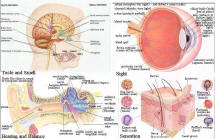
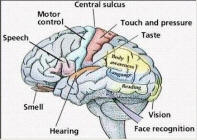
Senses organs receive external and internal stimuli; therefore, they are called receptors. Each type of receptor is sensitive to only one type of stimulus as listed Table 05, while Figure 09 shows many types of receptors. When a receptor is stimulated, it generated nerve impulses that are transmitted to the spinal cord and/or the brain, but we are conscious of a sensation only if the impulses reach the cerebrum.
Figure 09 Senses
[view large image]
Figure 10 Cerebrum Mapping [view large image]
| Receptor | Type | Sense | Stimulus |
|---|---|---|---|
| General | |||
| Ruffini's endings, Krause end bulbs | Radioreceptor | Hot-cold | Heat flow |
| Merkel's and Meissner's endings | Mechanoreceptor | Touch | Mechanical displacement of tissue |
| Pacinian corpuscles | Mechanoreceptor | Pressure | Mechanical displacement of tissue |
| Free nerve endings | Chemoreceptor | Pain | Tissue damage |
| Proprioceptors | Mechanoreceptor | Limb placement | Mechanical displacement |
| Special | |||
| Eye | Radioreceptor | Sight | Light |
| Ear | Mechanoreceptor | Hearing | Sound wave |
| Olfactory cells | Chemoreceptor | Smell | Chemicals |
| Taste buds | Chemoreceptor | Taste | Chemicals |
Table 05 Receptors
wave
The general receptors distribute all over the skin. They are usually grouped together as sensation. The special receptors locate only at certain part of the body in the head. Altogether, they are referred to as the five senses. The followings present a further break down into components, and functions.
-
Sight (see location of the various
components in Figure 09):
- Sclera - This is the white of the eye. It is a tough whitish sheath covering most of the eye (see Figure 11). The inter-cellular space contains a kind of loose proteins composed of collagen and elastic fibers, which make the wall of the eyeball more pliant.
- Cornea - It is almost perfectly transparent at the front of the sclera for the protection of the eye. Light rays is refracted through this dome-shaped structure.
- Choroid - The soft layer inside the sclera. It has many blood vessels that nourish the eye. It also absorbs stray light.
- Ciliary body - The choroid becomes suspensory ligaments near the opening. It holds the lens in place, and controls the shape of the lens for near and far vision.
- Iris - Further toward the opening, the choroid becomes a thin, circular, muscular diaphragm known as the iris, which regulates the size of a center hole (the pupil) and thus controls the amount of light entering into the eye. The pupil gets larger in dim light and smaller in bright light.
- Aqueous humor - This is the anterior cavity between the cornea and the lens. It is filled with an alkaline, watery solution secreted by the ciliary body. Normally, the solution leaves the anterior cavity by way of tiny ducts that are located where the iris meets the cornea. When a person has glaucoma, these drainage ducts are blocked, and aqueous humor builds up. The resulting pressure compresses arteries that serve the nerve fibers of the retina. The nerve fibers begin to die due to lack of nutrients, and the person becomes partially blind.
- Lens - It is a fat disk that completes the focusing of light rays into a clear, sharp image on the retina. Actually, the cornea provides about 80% of the focusing power. The lens is stretched by the ciliary muscles to fine-tune the focus by changing the shape, so it becomes fat for near objects, thin for far ones.
- Vitreous humor - The posterior cavity behind the lens
contains a viscous, gelatinous material. It forms the bulk
inside the eyeball and, with the outer sclera, gives it
firmness. It also helps to refract light rays toward the retina.
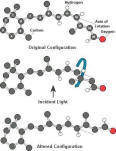
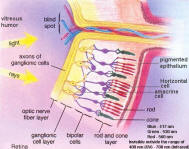
- Retina - Inside each light-sensitive cell (rod or cone) in the retina are up to 100 million molecules of photopigment, each of which contains a smaller molecule known as retinal (Figure 12a). When retinal receives light energy, it changes shape by twisting around its backbone. The altered retinal sets off a chain of chemical reactions inside the cell, which triggers an electro-chemical change in the cell membrane creating a nerve impulse. The retinal returns to its original configuration when the signal jumps across a synapse to a bipolar cell. Curiously, in order to
- Pigment epithelium - Epithelial cells are the guards and protectors of the organ. They cover the surface and determine which substances are allowed to enter.
- Rods and cones - These are the photoreceptors. The rods are responsible for night vision, and the cones for color vision. The retina has as many as 150 million rods but only 1 million ganglionic cells and optic nerve fibers. This means that there is considerable mixing of messages and a certain amount of integration before nerve impulses are sent to its final destination. The photoreceptors achieve the remarkable sensitivity (of a millionfold difference in luminance) with adjustment relative to the average background. But if the overall background level of illumination were to change drastically, as it does when we enter a dark room, we are effectively blind for a few minutes until the rod photoreceptors have adapted to this level of reduced intensity. Vision is most acute in the fovea centralis (see Figure 09), where there are only cone cells. Clear vision is possible only when the fovea inspects a scene. This provides a very restricted window of clarity. Thus in order to obtain a clear picture, the eyes have to dart about frenetically and automatically under the direction of the brain.
- Bipolar cells - Nerve signals from the rods and cones pass inward to this layer. The bipolar cells together with the horizontal and amacrine cells form the network of pre-processing nerve cells. The network helps to simplify, and code information before it reaches the optic nerve.
- Ganglionic cell layer - It receives input from the pre-processing network, and send output to the brain via the axons of the ganglion cells.
- Optic nerve - It is made up of nerve fibers, which come from across the whole retina. They pass in front of the retina, forming the optic nerve, which turns to pierce the layers of the eye. The signals eventually end up in the occipital lobe to form an image.
- Optic Pathway - As shown in Figure 13, information about the left visual world is transmitted to the right side of the brain and vice versa. As the visual fields of the eyes overlap in the front, this division is achieved by sorting retinal ganglion cell axons according to whether they look at the left (dotted line) or the right (solid line) visual field. So some axons from the right eye go to the right side of the brain and others to the left. The sorting occurs in the optic chiasm. The retinal axons proceed to the lateral geniculate nuclei where the first synapses are fromed with the visual neurons in the brains.
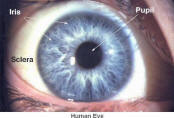 |
|
Figure 11 Human Eye
|
|
Figure 12a Retinal
[view large image]
Figure 12b Retina
[view large image]
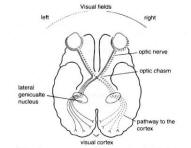 |
|
Figure 13 Optic Pathway
|
-
Hearing (see location of the
various components in Figure 09):
- Outer Ear -
- Pinna - This is the external flap for collecting sound wave.
- Auditory canal - The opening of the auditory canal is lined with fine hairs and sweat glands. The modified sweat glands secrete earwax to guard the ear against the entrance of foreign materials, such as air pollutants.
- Middle Ear -
- Tympanic membrane (ear drum) - It pushes a set of three small bone (the ossicles) against an inner membrane.
- Ossicles - The three parts in this structure are: hammer, anvil, and stirrup. These components multiply the sight vibration of the sound by about 20 times. When the stirrup strikes the oval window, the pressure is passed to the fluid within the inner ear.
- Eustachian tube - It extends from each middle ear to the nasopharynx and permit equalization of air pressure. Chewing gum, yawning, and swallowing in elevators and airplanes help to move air through the eustachian tubes upon ascent and descent.
- Inner Ear - Whereas the outer ear and the middle contain
air, the inner ear is filled with fluid. Anatomically speaking,
it has three areas: the first two, the semicircular canals and a
vestibule, are concerned with balance; only the third, the
cochlea, is concerned with hearing. It is a very delicate and
sophisticated organ about 1 cm3 in size.
- Scala vestibuli - The incoming vibration (red arrows in Figure 14) spirals along this structure toward the apex of the cochlea. At the apex, a small gap allows the wave to pass into the scala tympani.
- Scala tympani - The wave travel down (blue arrows) in this spiraling tube toward the round window.
- Round window - It acts as a pressure relief membrane dissipating the vibrational energy.
- Organ of Corti - This structure is set onto the basilar
membrane which forms one of the arms of the Y
inside the cochlea (see Figure 14). Pressure changes in the
fluid outside the scala media create vibrations in the
basilar membrane and in the Reissner's membrane, which forms
the other arm of the Y. The vibrations in the
scala media and the tectorial membrane shake the hair cells,
which convert the vibrational energy into electrical nerve
impulses. The signals are channeled by nerve fibers along
the organ of Corti to the main cochlear nerve, and then to
the temporal lob of the brain for processing into the sounds
that we perceive.
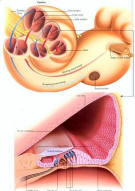
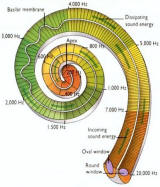
According to the frequency of the sound wave, different parts of the basilar membrane along the organ of Corti are set into motion. In general, low-pitch sounds make the apex of the cochlea vibrate while high-pitched ones cause most vibrations near the base of the cochlea. Figure 15 shows such frequency distribution along the length of the cochlea for both the incoming and outgoing waves. The strength of nerve signals also depends on the volume of the sound. This is interpreted by the brain as loudness. It is believed that tone is an interpretation of the brain based on the distribution of hair cells stimulated.Figure 14 Cochlea
[view large image]Figure 15 Sound Wave
[view large image]
For the sense of smell & taste please continue to next page
a illustrated guide to human senses, tongue, ear, touch, eye updated